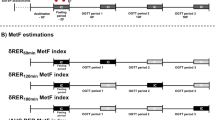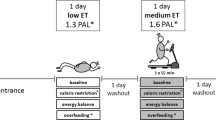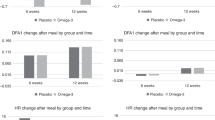Abstract
OBJECTIVE: The aim of this study was to look for a relationship between autonomic dysfunction and alterations in glucose- induced thermogenesis (GIT) and lipid oxidation rate in obese non-diabetic women.
SUBJECTS: 37 obese women, 20 with impaired cardiac autonomic function tests (group 1) were matched with 17 women with normal tests (group 2) according to age, weight, body mass index (BMI), waist-to-hip ratio (WHR), fat mass (FM) and fat free mass (FFM).
MEASUREMENTS: A series of five standardized tests was carried out, three of which were based mainly on cardiac parasympathetic control (heart rate response to Valsalva, deep breathing and lying-to-standing) and two on cardiovascular sympathetic function (blood pressure response to standing and to handgrip). Energy expenditure (EE), lipid and glucose oxidation rate were determined by indirect calorimetry at fasting and after an oral glucose load (75 g). Blood glucose, insulin and catecholamines responses to glucose were examined.
RESULTS: There was no significant difference in plasma glucose, insulin, catecholamines, metabolic rate, glucose and lipid oxidation rate at fasting and plasma glucose, insulin and catecholamine responses to glucose. GIT was slightly but not significantly lower in group 1 (24.7±10.4 kJ) than in group 2 (46.8±9.0 kJ). The cumulative glucose oxidation rate did not differ significantly in the two groups. The cumulative lipid oxidation rate was significantly lower in group 1 than in group 2 (−49.4±4.1 vs −30.8±8.0, respectively, P=0.033). It correlated negatively with the area under the curve of insulin response (r=−0.37, P=0.04). In the multivariate analysis, both autonomic dysfunction and the area under the curve of insulin response correlated significantly with the cumulative lipid oxidation rate.
CONCLUSION: This study suggests that 1) the glucose-induced inhibition of the lipid oxidation rate in obese women is greater in the patients with autonomic dysfunction; 2) a decrease in sympathetic activity is likely to be involved in this phenomenon.
This is a preview of subscription content, access via your institution
Access options
Subscribe to this journal
Receive 12 print issues and online access
$259.00 per year
only $21.58 per issue
Buy this article
- Purchase on Springer Link
- Instant access to full article PDF
Prices may be subject to local taxes which are calculated during checkout
Similar content being viewed by others
Author information
Authors and Affiliations
Rights and permissions
About this article
Cite this article
Valensi, P., Lormeau, B., Dabbech, M. et al. Glucose-induced thermogenesis, inhibition of lipid oxidation rate and autonomic dysfunction in non-diabetic obese women. Int J Obes 22, 494–499 (1998). https://doi.org/10.1038/sj.ijo.0800609
Received:
Revised:
Accepted:
Published:
Issue Date:
DOI: https://doi.org/10.1038/sj.ijo.0800609
Keywords
This article is cited by
-
Alteration of Amine Oxidase Activity in the Adipose Tissue of Obese Subjects
Obesity Research (2004)
-
Cardiac Parasympathetic Activity Is Increased by Weight Loss in Healthy Obese Women
Obesity Research (2001)



